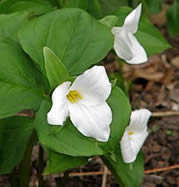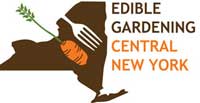Native Plants for Native Birds
| 
| Wild Birds Unlimited in Fayetteville has copies of the book Native Plants for Native Birds: A Guide for Birds In and Around Ithaca New York by Joel Baines.
Each plant has a 2-3 page description illustrated with photos. And the plants are native right here in Central New York. An excellent resource to have and an enjoyable book to read.
WBU also has Birds & Beans coffee, not available in most stores. It's certified as Bird-FriendlyŽ by the Smithsonian Migratory Bird Center.
about why this is important...)
Since quantities of any product can be limited, call ahead (637-0710) to confirm availability on any given day.
|
Some good programs at Baltimore Woods Nature Center
|
 | Trillium
(Trillium grandiflorum) |
| Birding Series: Kick It Up a Notch: Behavior and Calls
Wed., May 2, 7-8:30 pm. Fee.
Weekend Wildflower Walks Sat/Sun:
May 5/6 and May 12/13.
Join caretaker Audrey Loewer for a pleasant walk through the wonders of spring. Donations appreciated.
Signs of Spring
Tues, May 8, 10:30-11:30 am
Join a Naturalist for a walk along Baltimore Brook. Fee.
For info and to register, call the Woods at 673-1350.
|
| Be on the map: YardMap | 
| YardMap is an interactive citizen science project developed by Cornell's Lab of Ornithology. It's based on Google maps and allows you to draw maps of yards, parks and community gardens.
You share valuable habitat data with Lab of Ornithology scientists, connect with other people around the country, and learn about your ability to impact birds.
A video on the home page shows you how to do it.
Habitat gardeners have a lot to contribute to understanding how yards can help birds.
Sign up on the YardMap website.
|
| Our Habitat Garden |  |
Visit Our Habitat Garden website for information on providing habitat, earth-friendly gardening practices, plants, and various creatures here in Central New York.
|
|
Join HGCNY!
|  |
Becoming an official member of HGCNY is easy: just join Wild Ones! When you're a Wild Ones member, you're automatically an official member of HGCNY. |
| HGCNY on Facebook |
As as more of us participate on our Facebook page, this will become a useful resource for asking (and answering!) local HGCNYers' questions about habitat gardening. Join in what can become a very useful conversation about habitat gardening in Central New York.
|
| Our Edible Garden |  | | Visit OurEdibleGarden.org to see an example of a Central New York edible garden, the perfect companion to your habitat garden. |
| Interested in Edible Gardening? | 
|
If you'd like to get information on Edible Gardening CNY, just email John to find out about edible gardening tours and programs. |
|
Greetings!
April 29 Program: Bats  in the Habitat Garden in the Habitat Garden
We're pleased to have Jim D'Angelo, director of Sterling Nature Center, return to wrap up our regular season of programs. One of the first programs Jim presented to HGCNY many years ago was about bats. Since then, a mysterious fungus (White-nose Syndrome) has affected our bat population. Bats perform many valuable services, but myths abound about this fascinating mammal. Learn the facts about bats, the challenges they're facing and how you can welcome them into your habitat garden.
It's especially appropriate to talk about bats this year since it's the U.N. Year of the Bat with the motto "Save Bats to Save the Planet."
WHEN: Sunday, April 29 at 2:00 PM
WHERE: Liverpool Public Library (Directions)
Free and open to the public.
Come and bring a friend!
 | |
Catbird taking a sunbath
|
Want to learn more about habitat gardening?
I'll be giving four more presentations at Liverpool Library Tuesday nights from 6:30 to 8:00 pm. Free and open to the public. Come and bring a friend!
April 24: Monarchs and other butterflies
May 1: Our future flies on the wings of pollinators
May 8: Creating a bird-friendly yard
May 15: Designing an earth-friendly yard
~ Janet Allen
|
|
Let's plant milkweed!
 | |
Monarch laying an egg on swamp milkweed (Asclepias incarnata)
|
No milkweed,
no monarchs
Here's an update from Wild Ones and also a challenge for all us Wild Ones to Plant More Milkweeds to help save the monarch!
The Winter Population: Population estimates from the Mexican overwintering site indicate that Monarchs lost ground. Their population is down by 28% compared to the previous winter.
Big Factor in Decline is Loss of Milkweed: Dr. Karen Oberhauser (MN) co-authored research published in March showing that, in the past decade, there ...has been a 58% decline in milkweed and an 81% decline in monarch egg production in agricultural fields of the Midwest. Half of Monarchs come from the Midwest where caterpillars feed on common milkweed. The study ties a decade-long decline in monarch populations to the loss of milkweed from the corn and soybean fields that blanket the region.
The losses of monarchs coincide with the rise in the use of glyphosate herbicide, which kills
milkweed and other weeds, while leaving corn and soybean crops (genetically engineered to tolerate the herbicides) intact. They conclude that the loss of agricultural milkweeds is a major contributor to the decline in the monarch population. The smaller population makes the species more vulnerable to other conservation threats. Since this situation is unlikely to change, they encourage land managers and individuals to plant and conserve milkweed. Oberhauser said "it underlines the importance of putting milkweed in garden plantings, prairies, and roadsides." Read more from the University of Minnesota...
The Effect of the Texas Drought: The severe drought in Texas killed some milkweed plants down to the roots!
Canadian Study: Found that 10% of Monarchs reaching Canada came directly from Mexico. (The rest were progeny of a second or 3rd generation born along the way, in the central U. S.) Read more from Guelph University ...
To learn more about monarchs and milkweed here in Central New York, visit Our Habitat Garden. |
|
"But where do I find milkweeds?"
 | |
(Click image to download)
|
To help you find native plants in CNY, we've compiled a list of plants offered by several local nurseries. We're surprised to see that there are many more species offered than we suspected, which is very good news. REMEMBER, though, that nurseries can sell out of any particular plant, so it's always a good idea to call the nursery before setting out on your shopping trip! DOWNLOAD: This guide is available online as a free .pdf download, and we'll have hard copies available at our April meeting ($2 for non-members; free for Wild Ones members). |
|
Who's a Wild Ones/HGCNY member?
 | |
Click to join Wild Ones
Purple milkweed
(A. purpurascens)
|
Although we welcome everyone to our meetings, only people who have paid Wild Ones dues are official members of HGCNY. (Info on joining Wild Ones is in the left hand column or click the photo at right.)
Wild Ones/HGCNY members not only receive the Wild Ones Journal in the mail, but they also receive exclusive invitations to our annual field trip and other events. If you join now, you can sign up for this year's field trip to the Rome Sand Plains.
Most important, though, official Wild Ones/HGCNY members are not only providing financial support for our own HGCNY activities (such as the cost of this newsletter, our website etc.), but they're also supporting Wild Ones' national efforts to preserve biodiversity by educating about and advocating for planting native plants in natural landscapes.
(NOTE: As a 501(c)3 education and advocacy non-profit organization, Wild Ones dues are tax-deductible. HGCNY is a chapter of Wild Ones.) |
|
Featured plant: Milkweeds
Milkweeds are essential for monarchs. Their caterpillars can eat nothing else. The loss of milkweeds is a big factor in the decline of monarchs. Fortunately, this is something we can change, both in our own yards and in our public areas. All milkweeds are in the genus Asclepias. Here are some of the common species that are easy to grow here in Central New York.
 | Swamp milkweed
(A. incarnata)
|
Swamp milkweed (A. incarnata) is a very garden-worthy plant. Not only are the flowers attractive, but it doesn't spread underground. It's a perennial and only modestly self-sows. It grows in sun or part-shade to from 2 to 4 feet tall. As its name implies, it will grow in very wet areas, but it grows in regular garden soil, too. It's a monarch favorite, but it also provides nectar for pollinators.
 | Butterfly weed
(A. tuberosa) |
Butterfly weed (A. tuberosa) is another attractive, garden-worthy plant. Also a perennial, it's somewhat shorter at 1-3 feet tall. It grows in well-drained regular garden soil, but also in dry sandy soil. Like swamp milkweed, it's also well-behaved in a garden setting.
 | Common milkweed
(A. syriaca) |
Common milkweed ( A. syriaca) is not so well-behaved in the garden since it's large and spreads underground. If you have a suitable setting for it, though, it's a prime monarch plant. They love it! Nice big, tender leaves for the caterpillars! The flowers are attractive and have a heavenly scent for people, too. Although it's not perhaps the best garden plant, common milkweed is a plant we should promote in larger public areas. Unfortunately, it's often seen growing in ditches near roads ... until the highway department comes along and cuts it down -- probably due to complaints from citizens. Speak up for milkweed in these areas!Learn more about milkweed varieties, growing milkweeds, and more in Central New York at Our Habitat Garden. |
 | |
Inkberries (Ilex glabra)
|
From: Native Plants and Wildlife Gardens
The blog Native Plants and Wildlife Gardens: Healthy Gardens, Healthy Planet has some interesting posts. Here's a short summary of two recent ones. Southern New England's Native VinesThis blog post by Sue Sweeney describes many common as well as many less well known vines. Well illustrated with many photos. Read the post...The Secret Lives of Dioecious Plants
What's a dioecious plant? A plant that has male and female plants. To have berries on the females, you need a male. A familiar example is holly, but people may not realize that winterberries and inkberries are hollies, and therefore need to have both female and male plants. Read more ...
|
|
|
|
|